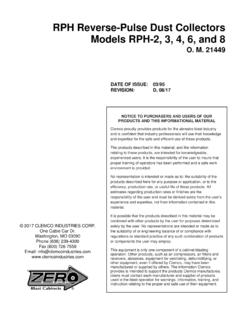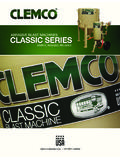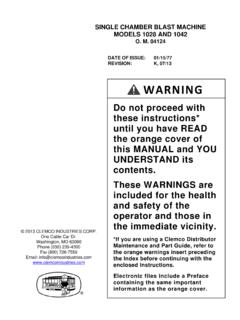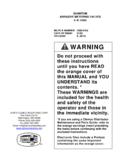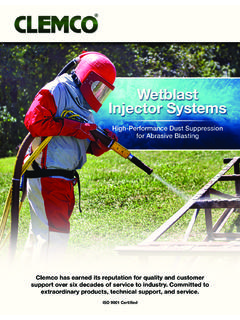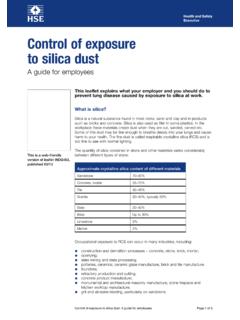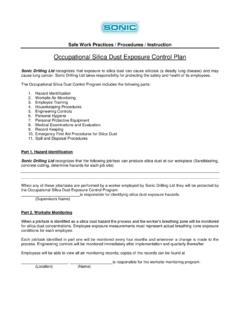Transcription of The Use of Personal Protective Equipment and …
1 The Use of Personal Protective Equipment and Regulations & Standards Affecting Safe Abrasive Blasting: By Thomas E. Enger, MS, CSP, CHMM, Clemco Industries Corp. Employers understand that safety is one of the most important ingredients to a successful business. However, providing a safe workplace and ensuring a safe and environmentally-sound environment is complex. Navigating the course to fool-proof safety can be mind-boggling. Since 1970, the primary references for determining the minimum safety and environmental standards in the workplace have been the Occupational Safety & and Health Administration (OSHA) and the Environmental Protection Agency (EPA) mandated by Titles 29 and 40 of the Code of Federal Regulations. These regulations incorporate thousands of standards from hundreds of agencies and organizations.
2 The purpose of this article is to attempt to provide the reader a basic understanding of the minimum standard to provide a safe work environment for their employees and the general public when using open-air abrasive blasting Equipment . There are three primary industries, which perform abrasive blasting; they are General Industry (29 CFR 1910), Maritime (29 CFR 1915), and Construction (29 CFR 1926). OSHA has developed regulations for these industries. The most basic elements of these standards include the following sections, which may be found on OSHA s website, They are: General Industry Maritime Construction Reference Title Reference Title Reference Title 29 CFR Incorporation By Reference 29 CFR Incorporation By Reference 29 CFR Personal Protective Equipment (PPE) 29 CFR (A) Ventilation Abrasive Blasting 29 CFR 1915 Subpart C Surface Preparation & Preservation 29 CFR Occupational Noise Exposure 29 CFR Occupational Noise Exposure 29 CFR Mechanical Paint Removers 29 CFR (F) Ventilation Abrasive Blasting 29 CFR 1910 Subpart I Personal Protective Equipment (PPE)
3 29 CFR Subpart I Personal Protective Equipment 29 CFR Hazard Communication 29 CFR PPE General Requirements 29 CFR PPE General Requirements 29 CFR 1926 Subpart E Criteria For Personal Protective Equipment 29 CFR PPE Eye & Face Protection 29 CFR PPE Eye & Face Protection 29 CFR PPE Occupational Foot Protection 29 CFR PPE Respiratory Protection 29 CFR PPE - Respiratory Protection 29 CFR PPE Head Protection 29 CFR PPE Head Protection 29 CFR PPE Head Protection 29 CFR PPE Hearing Protection 29 CFR PPE Occupational Foot Protection 29 CFR PPE Hand & Body Protection 29 CFR PPE Eye & Face Protection 29 CFR PPE Hand Protection 29 CFR 1915 Subpart K Portable, Unfired Pressure Vessels, Drums & Containers, Other Than Ship s Equipment 29 CFR Respiratory Protection 29 CFR Subpart M Compressed Gas & Compressed Air Equipment 29 CFR Portable Air Receivers & Other Unfired Pressure Vessels 29 CFR Air Receivers 29 CFR Air Receivers 29 CFR 1915 Subpart Z Toxic And Hazardous Substances 29 CFR 1926 Subpart Z Toxic And Hazardous Substances 29 CFR Hazardous (Classified) Locations 29 CFR Hazard Communication 29 CFR 1910 Subpart Z Toxic And Hazardous Substances Hazard Communication There are more than 40 references in 29 CFR which address the basic hazards associated with open air abrasive blasting.
4 The regulations governing these three industries address the requirement for Job Hazard Analysis (JHA) when the operator wears Personal Protective Equipment . Because a JHA is required by all the OSHA covered industries, I will use a JHA to identify not only the proper PPE but also to identify other hazards and relevant regulations as they apply to open air abrasive blasting. Table B contains a Job Hazard Analysis. This Job Hazard Analysis is modeled after OSHA publication #3071 and can be downloaded from Job Description: Blasting Setup Analyst: Tom Enger Date: April 1, 2009 Task/Activity Hazard Description Hazard Control Regulation - Standard Pot Tips, crush hand/fingers back injury; collateral damage Move Pot empty, use Mule, inspect wheels prior to moving, inspect work surface for tipping hazards.
5 Use Gloves & Steel Toe Shoes General Duty Clause, Section 5(a)(1) OSH Act &.138 & Subpart E & .157 Back Injury, sprain/strain (pot weight 600lbs, Abrasive weight 600lbs) Move Pot empty, Remove all abrasive prior to moving. Inspect wheels, inspect work surface General Duty Clause, Section 5(a)(1) OSH Act NIOSH Work Practices Guide for Manual Lifting PB94-176930 LJM Move Pot To Work Area Tilt Pot onto back wheels and push to work area. Upright Pot. Floor/Scaffold Failure Under Load Assure Scaffold/Floor is design to handle Load of Pot & Abrasive @ 1,200lbs 1926 Subpart L - Scaffold Specifications - Safety requirements for scaffolding. - Scaffolds or staging. Scaffolding Safety Requirements ANSI/ASSE Set Up Pot Hand Injury From Sharp/Rough Equipment Edges.
6 Heavy Cotton/Leather Gloves 29 CFR1926 Subpart E Add Abrasive Inhalation Hazard, When Adding Abrasive Type CE Abrasive-blast Respirator. Industrial Environmental Audit To Determine PELs (a) 29 CFR1910 Subpart Z 29 CFR1915 Subpart Z 29 CFR1926 Subpart Z 42 CFRpart84 Regulatory Violation ESD, explosion/fire(Hazards associated with these violation occur during operation of Equipment ) ESD/Conductive blast hose, metal couplings, conductive washers/blast hose system (b)(2)(i) (c)(1)(i) (c)(1)(ii) (c)(1)(iii) (b)(2)(i) Hook Up Blast Hose & Nozzle Regulatory Violation (Hazards associated with these violation occur during operation of Equipment ) Inspection/Quality of Hose, coupling, deadman, Whip-check/clips, Nozzle & Nozzle Support is a regulatory requirement.
7 (c)(2) (c)(1)(iii) (c)(1)(iv) (b)(1) (b)(5) (b)(7) (b)(10) Hook Up Air Supply Hose To Pot Regulatory Violation (Hazards associated with these violation occur during operation of Equipment ) Inspection/Quality of Hose, Coupling, Whip-checks/clips Pressure Reducing Valve On Air Supply Line (c)(2) (c)(1)(iii) (c)(1)(iv) (b)(1) (b)(5) (b)(7) conductive standard Job Description: Blasting Setup Analyst: Tom Enger Date: April 1, 2009 Task/Activity Hazard Description Hazard Control Regulation - Standard Inspect Pot For Damage Regulatory Violation (Hazards associated with these violations occur during operation of Equipment ) Inspect Compressor To assure relief valve is operable & Comp. Does not exceed pot rating.
8 Inspect For Non-approved ASME Welds/Modification (b)(3) (c) (b)(3) ASME-VIII, ,UG-125(g)(1) ASME-VIII, Div. 1, ?see terry Inspect Pot Piping Possible failure when pressure is turned on Inspect piping, especially piping in abrasive stream for wear and excessive rust. General Duty Clause, Section 5(a)(1) OSH Act Set Up Respirator & Put On Respirator Select Respirator Unapproved Respirator, Regulatory Violation (Hazards associated with these violations occur during operation of Equipment ) Assure you have NIOSH Respirator, Approved For Abrasive Blasting & toxins associated with surface and abrasive. 29 CFR (a)(5) 29 CFR (c)(3) 29 CFR (f)(5) 42 CFR Part 84 OSHA 3142 Lead In Construction NIOSH - Respirator User Notice: All Users of Type CE, Abrasive-Blast Supplied-Air Respirators NIOSH Respirator Selection Logic 2004 - Home Inspect Respirator Unapproved Respirator Assemblies, Damaged parts.
9 (Hazards associated with these violations occur during operation of Equipment ) Inspect Breathing Hose, Helmet, Air Hose, Air Control Valve, & Cape. All Parts Should be From Same Manufacturer. Check For Cleanliness. 29 CFR (a)(5) 29 CFR (c)(3) 29 CFR (f)(5) 29 (h)(3) 42 CFR Part 84 Inspect Absorbent Bed Filter Regulatory Violation (Hazards associated with these violations occur during operation of Equipment ) Absorbent Bed Filter is Normally Cartridge Type & is Replaceable. Check Housing & Regulator For Damage 29 CFR (I)(5)(iii)&(iv) 29 CFR 29 CFR 29 CFR (a)(6) Inspect Gage/Regulator At Respirator Connection Regulatory Violation (Hazards associated with these violations occur during operation of Equipment ) 29 CFR (I)(5) requires Respirator to Meet 42 CFR Part 84, This reg.
10 Requires use of Gage/Regulator 42 CFR Part (Gages) 42 CFR Part & .149 42 CFR Part Regulatory Violation, Improper Fittings or Tanks (Hazards associated with these violations occur during operation of Equipment ) Ensure breathing air couplings are incompatible with outlets for nonrespirable worksite air. Ensure breathing gas containers are marked for Breathing 29 CFR (I)(8) 29 CFR (I)(9) Connect Breathing Air Regulatory Violation, Non-complaint Breathing Air From Compressor (Hazards associated with these violations occur during operation of Equipment ) Use, Calibrate High temperature & Carbon Monoxide Alarm Place Compressor Intake away From contaminated air (car exhaust) 29 CFR (a)(6) 29 CFR (I) ANSI/CGA Put On Blast Suit Regulatory Violation, Blast Suit Mandated By OSHA (Hazards associated with these violations occur during operation of Equipment ) Put on Blast Suit Coveralls or appropriate alternative 29 CFR (a)(5)(v) 29 CFR 29 CFR 29 CFR 29 CFR (f)(5)(v) 29 CFR Put On Safety Shoes.

